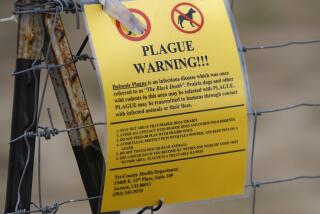Trouble in the bat cave
It’s October, which means that bats are once again having their annual star turn, popping up on classroom bulletin boards and store windows across America. But this year, actual living bats in North America aren’t so abundant. They are being decimated by a deadly health epidemic.
The disease causing this die-off is called white-nose syndrome, and it is infecting hibernating bat populations across the Eastern states. In the four years since it was first detected, white-nose syndrome has spread quickly from a cave in upstate New York, the epicenter, to 16 states and four Canadian provinces. It has killed more than 1 million bats.
Biologists in New York first started to notice dead and dying bats with unusual symptoms in 2007. Named for a fuzzy white fungus that often grows on the muzzles, wings and tail membranes of infected bats, white-nose syndrome had never been seen in North America. As winter wore on, more and more bats were affected by the disease, and biologists watched helplessly as the bats prematurely left their caves and died in droves in the ice and snow in the Northeast.
Video: 1 million bats dead from white-nose syndrome
Scientists worked quickly to identify the culprit, a newly found fungus associated with the disease, Geomyces destructans. European biologists noticed that many of their bats also had a white fungus on them but that they were not dying. Genetic comparison confirmed that the North American and European fungi were a match.
Scientists hypothesize that the fungus was accidentally introduced into the New York cave by a human visitor, and that Americans bats, unlike their European counterparts, have little or no resistance to white-nose syndrome.
The exact reasons are unknown. Physical differences may play a role (European bats tend to be bigger and may be better able to fight the infection). It’s also possible that European bats co-evolved with the fungus, which allowed them to develop resistance, or that environmental differences cause the fungus to behave differently in North America.
Global travel has made the introduction of foreign plants, animals and pathogens as easy as dropping anchor or hopping on a plane. Importers, anglers, explorers and even gardeners can easily transport invasive pathogens on clothing and footwear, or in shipments of goods.
Many bats are at risk. More than half of the 45 bat species living in the United States rely on hibernation for winter survival. But bats with white-nose syndrome exhibit deadly behavior during cold winter months, waking from hibernation and flying outside during the day in search of food and water. White-nose syndrome has an extremely high mortality rate — more than 95% of the infected bats at some sites in the Northeast have died. Sites where bat populations have been stable or increasing over the last 30 years are devoid of hibernating bats. Unless something changes, several species (including the once-common little brown bat) are facing regional extinction in the next decade.
Bats have never enjoyed a great reputation in American culture. They have been portrayed as human bloodsuckers, even though vampire bats, which don’t exist in the U.S., don’t feed on human blood. And they are blamed for transmitting rabies, although rabies is not more common in bats than in raccoons or skunks.
Worse still, bats are rarely given credit for what they excel at: insect pest control.
The loss of bat populations in the U.S. has serious implications for our economy and environment. A recently published study estimates that bats provide an average of $22 billion a year in pest control services to the nation’s agricultural industry, and this staggering figure does not include the forest products industry. Not only will there be fiscal costs if farmers, loggers and homeowners have to use more pesticides; there is the potential for negative environmental and human health effects.
The U.S. Fish and Wildlife Service is leading a cooperative international effort of more than 100 agencies and organizations to address the disease and conserve North American bat species. By year’s end, state and federal agencies will have spent more than $24.5 million on the investigation, but so far a solution eludes us.
As scientists continue their inquiries into what is behind white-nose syndrome, we and the bats need help from the public. First and foremost, it’s important not to spread the disease further. Many caves and mines are closed to protect hibernating bats. Cave explorers should check with their state conservation agency before entering any cave or mine, and they should follow the protocols recommended by the U.S. Fish and Wildlife Service to decontaminate clothing, footwear and equipment used in caves and mines.
People can also help by taking note of bats in their area, and reporting to a wildlife agency any new bat colonies or odd activity — such as bats flying in the day or roosting in sunlight on the outside of structures during the winter.
As you look at all the bat decorations this Halloween, spare a thought for the real bats and the crucial role they play in ecosystems across the country. They need your help.
Dan Ashe is director of the U.S. Fish and Wildlife Service. More information about bats and white-nose syndrome can be found at https://www.fws.gov/whitenosesyndrome
More to Read
A cure for the common opinion
Get thought-provoking perspectives with our weekly newsletter.
You may occasionally receive promotional content from the Los Angeles Times.










